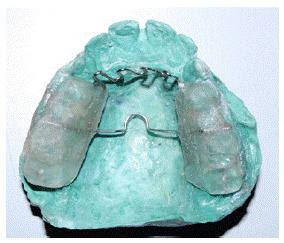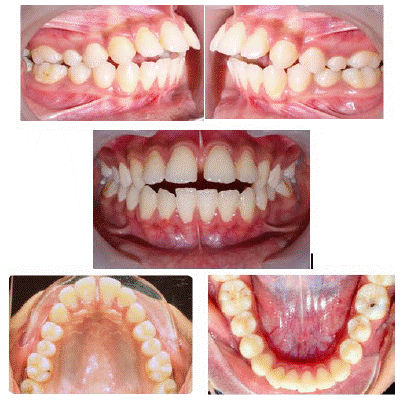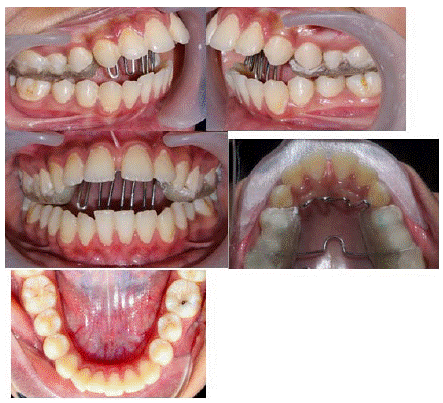
Case Report
Austin J Dent. 2022; 9(2): 1169.
Use of a Posterior Bite Block Modified with TPA and Palatal Crib for Treating Open Bite in Growing Individual: A Case Report
Daniel JJ1, Nizar A2*, Shetty KN3 and Kumar A4
1Assistant Professor, Pushpagiri College of Dental Sciences, India
2Post graduate student, AJ Institute of Dental Sciences, India
3Professor & HOD, Department of Orthodontics, AJIDS, India
4Reader, Department of Orthodontics, AJIDS, India
*Corresponding author: Asjad Nizar, Post Graduate Student, AJIDS, Mangalore, India
Received: November 02, 2022; Accepted: November 30, 2022; Published: December 07, 2022
Abstract
Background: The aim of this paper is to illustrate the use of a Posterior bite block modified with TPA and Palatal crib to obtain the vertical control of maxillary molars, restrict tongue pressure as well as Intruding posterior molars thereby auto rotating mandible.
Case Report: Use of posterior bite block modified with TPA and Palatal crib for correcting Anterior Open bite in growing individual is illustrated. Patient was successfully treated, and the open bite was fully corrected thanks to molar intrusion, following counter clockwise rotation of the mandible and tongue correction. Finishing of alignment was performed in phase II of the treatment with conventional appliances.
Conclusion: Posterior bite block modified with TPA and Palatal crib proved to be effective in controlling the vertical position of maxillary molars promoting the counter-clockwise rotation of the mandible and stimulating a different tongue posture.
Keywords: Openbite; Openbite correction; Growing individuals; Tongue pressure
Introduction
Anterior open bite is a challenging malocclusion characterised by a deficiency in the normal vertical overlap between anterior incisors edges when the posterior teeth are in occlusion [1]. The prevalence of anterior open bite ranges from 1.5% to 11% among different age and ethnic groups [Pisani et al., 2016; Harvold et al., 1981. Di Ventura et al., 2019; Nota et al., 2019; Carvalho et al., 2011].
The aetiological features of open bite can generally be grouped under three headings as follows [2]: 1. Disturbances in the eruption of the teeth and alveolar growth (e.g., ankylosed primary molar). 2. Mechanical interference with eruption and alveolar growth (e.g., finger-sucking habit). 3. Vertical skeletal dysplasia.
According to Proffit and Fields [3] [1983], the ideal timing to start interceptive treatment is during the mixed dentition because every modification in deciduous dentition has the potential to relapse due to ongoing growth-related changes. Since patients with this type of vertical growth are more susceptible to dental extrusion and further bite opening during conventional biomechanical therapy, several authors have proposed intraoral devices, similar to vertical holding appliances used during orthodontic treatment, to inhibit the maxillary molar over-extrusion and to promote a more favourable mandibular counter clockwise rotation [4,5] [Bascifici and Karaman, 2002; De Berardinis et al., 2000; Gracco and Spena, 2008; Wise et al., 1994; Linder Aronson et al., 1993; Shpak et al., 2006; Cerruto et al., 2018].
Materials and Methods
A posterior bite block is made with a clear acrylic on a working model which is modified with TPA made of 0.9mm stainless steel wire where U loop is made in a direction opposite to conventional TPA and it should be 2mm away from the tissue surface and a Palatal crib is made to restrict tongue pressure.
Case Report
A 16 yrs old female patient came to our department with a chief complaint of forwardly placed upper teeth. On extra oral examination she has convex profile, posterior divergence, mesomorphic build with athletic body type and mesocephalic head with incompetent lips.
On Intraoral examination, Patient presented with class I molar relation, anterior openbite, Proclined upper and lower incisors with midline diastema, lower arch crowding and tongue thrusting habit.
After examination she was diagnosed as Skeletal Class II base, with underlying Angle’s Class I malocclusion with anterior open bite and Proclined upper and lower anteriors, spacing in upper and crowding in lower anteriors and a vertical growth pattern.
Treatment Objectives
1. Correction of tongue thrusting habit.
2. Correction of open bite.
3. Correction of proclined upper and lower anteriors.
4. Correction of spacing in upper anteriors.
5. Correction of crowding in lower anterior region.
Treatment Plan
Non-extraction treatment plan is finalised and correction of anterior openbite by Intruding upper posteriors thereby autorotating mandible with the use of posterior biteblock modified with TPA and Palatal crib. So that we can achieve vertical control over upper molars at the same time intrusion of upper molars as well as we can restrict tongue pressure. After that, phase II with Conventional fixed appliance therapy. The appliance used is PEA MBT mechanotherapy in 0.022 SLOT.

Pre-Treatment Intra Oral Photographs

Posterior Bite Block Modified With TPA and Palatal Crib

After 6 Months of Treatment, Anterior Openbite Is Corrected and Strap
Up With 0.014 Niti on Both Arches

After 6 Months of Treatment, Anterior Openbite Is Corrected and Strap
Up With 0.014 Niti on Both Arches
Discussion
Open bite malocclusion is a difficult to treat in orthodontic practice. Treatment modalities include functional appliances in growing children and surgeries in adults. Minor cases can be treated by fixed orthodontics along with some habit breaking appliances. Relapse rates are highest in this type of malocclusion. Functional efficiency of the stomatological system is undermined in such cases. Extra care should be taken while diagnosing and planning treatment for such these cases as any error in identifying the etiology may lead to a poor end result.
In this case Posterior biteblock modified with TPA and Palatal crib proved to be effective in controlling the vertical position of maxillary molars promoting the counter-clockwise rotation of the mandible and stimulating a different tongue posture.
Conclusion
Open-bite malocclusion is the one in treatment group, which has the most possibility of relapse. The most important feature for dental treatment is the stability of treatment. The functional treatment methods, when applied in early and active stages of growth and development, provide positive stable results by turning vertical development towards horizontal development.
References
- Bascifici FA, Karaman. Effects of a modified acrylic bonded rapid maxillary expansion appliance and vertical chin cap on dentofacial structures. Angle Orthod. 2002; 72: 61-71.
- Burke M, Jacobson A. Vertical changes in high-angle Class II division 1 patients treated with cervical or occipital pull headgear. Am J Orthod Dentofacial Orthop. 1992; 102: 501-508.
- Cangialosi TJ. Skeletal morphologic features of anterior open bite. Am J Orthod Dentofacial Orthop. 2003; 85: 28–36.
- Carvalho AC, Paiva SM, Scarpelli AC, Viegas CM, Ferreira FM, Pordeus AI. Prevalence of malocclusion in primary dentition in a population-based sample of Brazilian preschool children. Eur J Paediatric Dent. 2011; 12: 107-111.
- Cerruto C, Cozzani P, Cozzani M. Compliance-free and non-invasive treatment of an anterior open bite in a 11-year-old girl. Eur J Paediatric Dent. 2018; 19: 282-286.
- Gracco A, Spena R. Vertical control in nonextraction treatment of growing patients with anterior skeletal open bite. J Clin Orthod. 2008; 42: 443-9.
- Proffit WR, Fields HW. Occlusal forces in normal and long face children. J Dental Res. 1983; 62: 571-4.
- Urzal V, Braga AC, Ferreira AP. Oral habits as risk factors for anterior open bite in the deciduous and mixed dentition – cross-sectional study. Eur J Paediatric Dent. 2013; 14: 299-302.
- Wise J, Magness WB, Powers J. Maxillary molar vertical control with the use of transpalatal arches. Am J Orthod Dentofacial Orthop. 1994; 106: 403-8.